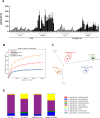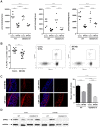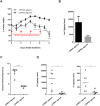Western diet induces a shift in microbiota composition enhancing susceptibility to Adherent-Invasive E. coli infection and intestinal inflammation
- PMID: 26742586
- PMCID: PMC4705701
- DOI: 10.1038/srep19032
Western diet induces a shift in microbiota composition enhancing susceptibility to Adherent-Invasive E. coli infection and intestinal inflammation
Abstract
Recent advances have shown that the abnormal inflammatory response observed in CD involves an interplay among intestinal microbiota, host genetics and environmental factors. The escalating consumption of fat and sugar in Western countries parallels an increased incidence of CD during the latter 20(th) century. The impact of a HF/HS diet in mice was evaluated for the gut micro-inflammation, intestinal microbiota composition, function and selection of an E. coli population. The HF/HS diet created a specific inflammatory environment in the gut, correlated with intestinal mucosa dysbiosis characterized by an overgrowth of pro-inflammatory Proteobacteria such as E. coli, a decrease in protective bacteria, and a significantly decreased of SCFA concentrations. The expression of GPR43, a SCFA receptor was reduced in mice treated with a HF/HS diet and reduced in CD patients compared with controls. Interestingly, mice treated with an agonist of GPR43 were protected against DSS-induced colitis. Finally, the transplantation of feces from HF/HS treated mice to GF mice increased susceptibility to AIEC infection. Together, our results demonstrate that a Western diet could aggravate the inflammatory process and that the activation of the GPR43 receptor pathway could be used as a new strategy to treat CD patients.
Figures







Similar articles
-
Western diet induces dysbiosis with increased E coli in CEABAC10 mice, alters host barrier function favouring AIEC colonisation.Gut. 2014 Jan;63(1):116-24. doi: 10.1136/gutjnl-2012-304119. Epub 2013 Apr 18. Gut. 2014. PMID: 23598352
-
Propionate catabolism by CD-associated adherent-invasive E. coli counteracts its anti-inflammatory effect.Gut Microbes. 2021 Jan-Dec;13(1):1-18. doi: 10.1080/19490976.2020.1839318. Gut Microbes. 2021. PMID: 33769191 Free PMC article.
-
Association of Adherent-invasive Escherichia coli with severe Gut Mucosal dysbiosis in Hong Kong Chinese population with Crohn's disease.Gut Microbes. 2021 Jan-Dec;13(1):1994833. doi: 10.1080/19490976.2021.1994833. Gut Microbes. 2021. PMID: 34812117 Free PMC article.
-
Nutrition, oxidative stress and intestinal dysbiosis: Influence of diet on gut microbiota in inflammatory bowel diseases.Biomed Pap Med Fac Univ Palacky Olomouc Czech Repub. 2016 Dec;160(4):461-466. doi: 10.5507/bp.2016.052. Epub 2016 Oct 26. Biomed Pap Med Fac Univ Palacky Olomouc Czech Repub. 2016. PMID: 27812084 Review.
-
Understanding host-adherent-invasive Escherichia coli interaction in Crohn's disease: opening up new therapeutic strategies.Biomed Res Int. 2014;2014:567929. doi: 10.1155/2014/567929. Epub 2014 Dec 15. Biomed Res Int. 2014. PMID: 25580435 Free PMC article. Review.
Cited by
-
Excreta biomarkers in response to different gut barrier dysfunction models and probiotic supplementation in broiler chickens.PLoS One. 2020 Aug 13;15(8):e0237505. doi: 10.1371/journal.pone.0237505. eCollection 2020. PLoS One. 2020. PMID: 32790727 Free PMC article.
-
Emulsifiers Impact Colonic Length in Mice and Emulsifier Restriction is Feasible in People with Crohn's Disease.Nutrients. 2020 Sep 15;12(9):2827. doi: 10.3390/nu12092827. Nutrients. 2020. PMID: 32942699 Free PMC article.
-
Ultra-processed foods in a rural Ecuadorian community: associations with child anthropometry and bone maturation.Br J Nutr. 2023 Nov 14;130(9):1609-1624. doi: 10.1017/S0007114523000624. Epub 2023 Mar 13. Br J Nutr. 2023. PMID: 36912073 Free PMC article.
-
Decreased Enteric Bacterial Composition and Diversity in South American Crohn's Disease Vary With the Choice of Treatment Strategy and Time Since Diagnosis.J Crohns Colitis. 2020 Jul 9;14(6):791-800. doi: 10.1093/ecco-jcc/jjz189. J Crohns Colitis. 2020. PMID: 31758685 Free PMC article.
-
A nutritional approach to microbiota in Parkinson's disease.Biosci Microbiota Food Health. 2019;38(4):115-127. doi: 10.12938/bmfh.19-002. Epub 2019 Jun 29. Biosci Microbiota Food Health. 2019. PMID: 31763115 Free PMC article. Review.
References
-
- Xavier R. J. & Podolsky D. K. Unravelling the pathogenesis of inflammatory bowel disease. Nature 448, 427–434 (2007). - PubMed
-
- Cosnes J., Gower-Rousseau C., Seksik P. & Cortot A. Epidemiology and natural history of inflammatory bowel diseases. Gastroenterology 140, 1785–1794 (2011). - PubMed
-
- Seksik P. et al. Review article: the role of bacteria in onset and perpetuation of inflammatory bowel disease. Aliment. Pharmacol. Ther. 24 Suppl 3, 11–18 (2006). - PubMed
-
- Baumgart M. et al. Culture independent analysis of ileal mucosa reveals a selective increase in invasive Escherichia coli of novel phylogeny relative to depletion of Clostridiales in Crohn’s disease involving the ileum. ISME J. 1, 403–418 (2007). - PubMed
Publication types
MeSH terms
Substances
LinkOut - more resources
Full Text Sources
Other Literature Sources
Research Materials
Miscellaneous

